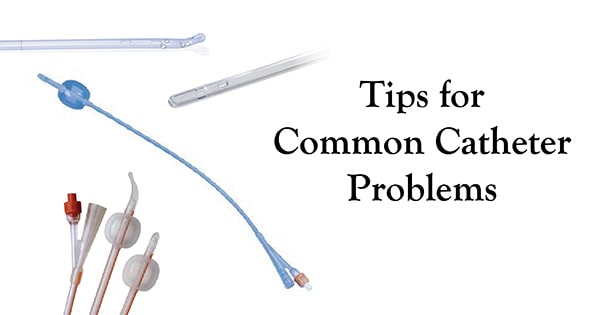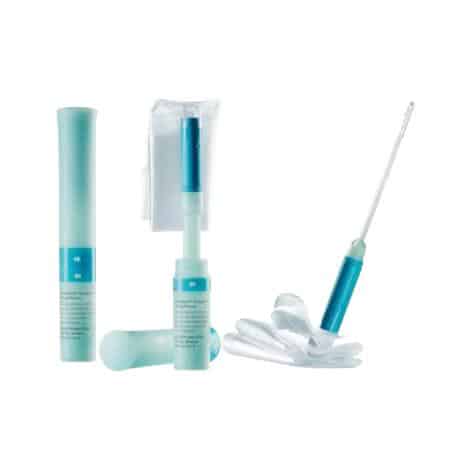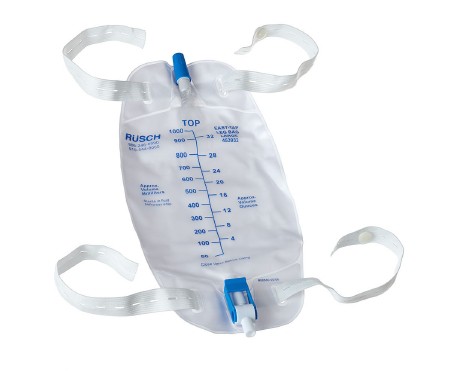Whether you are new to catheterization or have been using a catheter for years, there are common catheter problems you might experience. Urinary catheters may be recommended by your doctor for various reasons and are a necessary part of controlling and emptying your bladder. You may be using a catheter for a short amount of time or long term. Either way, we will discuss some of the common catheter problems you may experience along the way and what can be done to alleviate the issues.
The Three Types of Catheters and Common Problems with Each
1. Intermittent Catheters
Intermittent catheters are designed to be single-use tubes that pass through the urethra to drain the bladder and then be discarded. As the name suggests, they do not remain in the bladder for a long time but are instead used in intervals throughout the day. An intermittent catheter may be inserted in the hospital by a doctor during surgery, or it may be self-inserted every few hours to empty the bladder (self-catheterization).
Common Problems with Intermittent Catheters
The intermittent catheter will not go in.
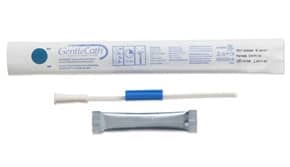 You should never force a catheter in due to the risk of damaging the sensitive urethral tissue. Try removing the catheter, taking a deep breath, and try again in a few minutes. If you are still unsuccessful and your bladder is uncomfortably full, you should visit your nearest emergency room for immediate assistance.
You should never force a catheter in due to the risk of damaging the sensitive urethral tissue. Try removing the catheter, taking a deep breath, and try again in a few minutes. If you are still unsuccessful and your bladder is uncomfortably full, you should visit your nearest emergency room for immediate assistance.
No urine is draining from the intermittent catheter.
It is possible that the lubricating jelly used to insert the intermittent catheter has blocked the flow of urine through the drainage eyelets. You can try coughing to help start urine flow for this common catheter problem.
Also, check to make sure you have inserted the intermittent catheter correctly. For females, check to see that you have not accidentally inserted the catheter into the vagina. For males, ensure that you have inserted the intermittent catheter far enough into the urethra from proper drainage. You should see approximately ten centimeters of the catheter’s end visible.
You are experiencing frequent urinary tract infections (UTIs).
Most catheter-associated urinary tract infections (CAUTIs) are caused by bacteria entering the urethra. CAUTIs are among the most common catheter problems and should be treated immediately by a doctor before it leads to further complications. One of the ways to help prevent CAUTIs is using closed-system catheters. Closed-system catheters allow for a completely touchless catheterization experience, reducing the risk of bacteria entering the urethra.
As with any UTI, it is advised to drink plenty of water throughout the day. By drinking enough fluids, you can help flush any bacteria away.
Another side note about CAUTIs is that the longer the catheter remains in place, such as with a Foley catheter, the higher the risk of repeat CAUTIs. And, since the female urethra is closer to the anus than with men, a CAUTI is more likely to occur in women than men.
2. Foley Catheters
A Foley catheter is also commonly referred to as an indwelling catheter because it is inserted into the bladder and remains there prolonged. Near the tip of the Foley catheter is a balloon. Once the Foley catheter is inserted into the bladder, the balloon is filled with sterile water. This expanded balloon prevents the Foley catheter from moving out of place.
More detailed information, including Foley catheter accessories and Foley catheter sizing, can be found on our Foley Catheter Products page.
Common Problems with Foley Catheters
There is leaking around the Foley catheter.
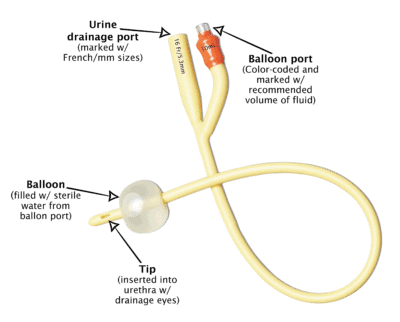 When the urine bypasses the catheter, leakage occurs. Check to make sure there are no kinks in the catheter and the drainage bag tubing that may be causing the leakage.
When the urine bypasses the catheter, leakage occurs. Check to make sure there are no kinks in the catheter and the drainage bag tubing that may be causing the leakage.
Another common catheter problem with a Foley catheter that is leaking is that it could also be blocked. If you have checked that there are no kinks in the catheter and drainage bag tubing and are uncomfortable because of your full bladder, go to your nearest emergency room immediately to resolve the blockage.
The Foley catheter has fallen out.
The balloon on a Foley catheter is inflated with sterile water and holds the catheter in place inside the bladder, preventing it from falling out. Be sure to check and see that the balloon did not accidentally deflate, meaning it could be faulty. The balloon size could also be the problem the Foley catheter has fallen out of the bladder. You should seek medical attention immediately if your Foley catheter has fallen out.
3. External Catheters
External catheters are also referred to as condom catheters or Texas catheters. Most external catheters are designed for men. However, female external catheters such as the Purewick Female External Catheter do exist.
Male external catheters are placed over the penis much like a condom. This external catheter features a plug at the end that attaches to a urinary drainage bag attached to the upper leg with catheter straps. These male external catheters are also self-adhesive and less likely to cause UTIs commonly associated with frequent intermittent catheterization.
Common Problems with External Catheters
The skin has become irritated.
 You may be allergic to the material or adhesive of the external catheter. You should consult your doctor, who may recommend an alternate external catheter to try.
You may be allergic to the material or adhesive of the external catheter. You should consult your doctor, who may recommend an alternate external catheter to try.
The skin irritation could also be caused due to improper sizing of the external catheter. If the catheter is too tight around the penis, friction can occur, leading to skin irritation. If the external catheter is too large, leakage can occur, contributing to skin problems from fluids.
You are experiencing urine backflow.
A common catheter problem with external catheters is backflow. If urine is coming out of the top of the catheter, the first thing to check is to make sure that the drainage bag is below the bladder level. This is the case for all catheters, not just external catheters. Gravity will pull the urine downward, and if the drainage bag is above the bladder level, it will likely cause backflow.
Removing the catheter is painful.
If you experience pain when removing the external catheter, try putting a warm washcloth around the external catheter for a few minutes. The warmth of the washcloth can help loosen the adhesive used when applying the external catheter, allowing for smooth removal.
Other Catheter Problems That Require Immediate Attention
Although the above lists some of the most common catheter problems, it is not complete. There are other symptoms to watch for. You should seek medical attention immediately if you are experiencing any of the following:
- Continuous bladder spasms or stomach cramps
- Cloudy, fowl, or strong-smelling urine
- Stones are sediment in the urinary drainage bag
- Drinking enough fluids but little or no urine draining
- Burning sensation around the catheter
- Blood in the urine drainage bag or around the catheter point of entry
- Swelling of the urethra at the catheter point of entry
- Fever or chills
For help finding any intermittent, Foley, or external catheters we offer at Personally Delivered, give us a call. One of our helpful and knowledgeable Catheter Product Experts is happy to help. Remember, catheterization should never be uncomfortable, and we hope that some of these tips for common catheter problems you can find helpful.
